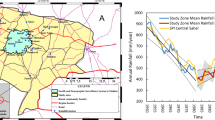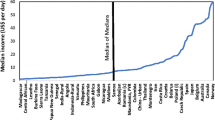Abstract
This article explores the extent to which efforts to improve productivity of smallholder agriculture through a new ‘Green Revolution’ in Sub Saharan Africa are likely to enhance the capacity of smallholder farmers to adapt to the impacts of climate change. Drawing on empirical material from Malawi and Kenya, the paper finds more conflicts than synergies between the pursuit of higher productivity through the promotion of hybrid maize adoption and crop diversification as a strategy for climate change adaptation. This is despite an oft-assumed causal link between escape from the ‘low maize productivity trap’ and progression towards crop diversification as an adaptive strategy. In both countries, a convergence of interests between governments, donors and seed companies, combined with a historical preference for, and dependence on maize as the primary staple, has led to a narrowing of options for smallholder farmers, undermining the development of adaptive capacities in the longer term. This dynamic is linked to the conflation of market-based variety of agricultural technologies, as viewed ‘from the top down’, with diversity-in-context, as represented by site-specific and locally derived and adapted technologies and institutions that can only be developed ‘from the bottom up’.
Similar content being viewed by others
Notes
This programme is alternately referred to as the Farm Input Subsidy Programme (FISP) and Agricultural Input Subsidy Programme (AISP).
Akin Adesina, speaking on behalf of AGRA at a conference to review progress in implementing Kenya’s ‘Strategy for Revitalising Agriculture’ (SRA), Nairobi 11th November 2008.
The CIMMYT-led ‘Drought Tolerant Maize for Africa’ (DTMA) http://dtma.cimmyt.org/ and an AATF-brokered public-private partnership named Water-Efficient Maize for Africa (WEMA), both with substantial support from the Bill and Melinda Gates Foundation http://wema.aatf-africa.org/ (1 March 2013).
These issues are brought into sharp focus in a short film by the University of Sussex-based STEPS Centre, entitled ‘Seeds and Sustainability’ http://vimeo.com/20239062 (1 March 2013).
References
Adger WN (2006) Vulnerability. Glob Environ Chang 16:268–281
Adger WN, Arnell NW, Tompkins EL (2005) Successful adaptation to climate change across scales. Glob Environ Chang 15:77–86
Adger WN, Brown K, Tomkins EL (2006) The political economy of cross-scale networks in resource co-management. Ecol Soc 10(2):9
Alarcon D & Bodouroglou C (2011) Sustainable Agricultural Innovation Systems (SAIS) for Food Security and Green Economies. International Conference on Green Economy and Sustainable Development. UNRISD, Geneva (10–11 Oct). Available at: www.unrisd.org/80256B42004CCC77/(httpInfoFiles)/CAB6618273F277C0C12579290041EB16/$file/6-1%20Alarcon%20and%20Bodouroglou, 2011
Borras SM, McMichael P, Scoones I (2010) The politics of biofuels, land and agrarian change: editors’ introduction. J Peasant Stud 37:575–592
Brooks S, Burges-Watson D, Draper A, Goodman M, Kvalvaag H, Wills W (2013) Chewing on choice. In: Abbots EJ, Lavis A (eds) Why we eat, how we eat: Contemporary encounters between food and bodies. Ashgate, London
Brooks S, Loevinsohn M (2011) Shaping agricultural innovation systems responsive to food insecurity and climate change. Nat Res Forum 35:185–200
Brooks S, Thompson J, Odame H, Kibaara B, Nderitu S, Karin F, Millstone E (2009) Environmental change and maize Innovation in Kenya: exploring pathways in and out of maize. STEPS Working Paper 36. STEPS Centre, Brighton
Chinsinga B (2011) Seeds and subsidies: the political economy of input programmes in Malawi. IDS Bull 42:59–68
Chinsinga B, Chasukwa M, Naess LO (2012) Climate change and agricultural policy processes in Malawi. Working Paper 046. Future Agricultures, Brighton
Chinsinga B, Mangani R, Mvula P (2011) The political economy of adaptation through crop diversification in Malawi. IDS Bull 42:110–117
Chirwa EW, Dorward A, Matita M (2011) Conceptualising graduation from agricultural input subsidies in Malawi. Working paper 29. FAC, Brighton
de Groote H, Owuor G, Doss CR, Ouma J, Muhammad L, Danda K (2005) The maize green revolution in Kenya revisited. J Agric Dev Econ 2:32–49
Devereux S (1998) The New famines: Why famines exist in an era of globalization, Routledge
Devereux S (2009) Why does famine persist in Africa? Food Secur 1:25–35
Dorward A, Chirwa E (2011) The Malawi agricultural input subsidy programme: 2005-6 to 2008-9. Int J Agric Sustain 9:232–249
Edquist C (1997) Systems of innovation: Technologies, institutions and organisations. Pinter, London and Washington
Ely A, Van Zwanenberg P, Stirling A (2013) “Broadening out and opening up technology assessment: Approaches to enhance international development, co-ordination and democratisation” Res Polic. doi:10.1016/j.respol.2013.09.004
Foresight (2011) The future of food and farming: Challenges and choices for global sustainability. Final Project Report. London: The Government Office for Science
Freeman C (1995) The ‘National System of Innovation’ in historical perspective. Camb J Econ 19:5–24
Gallopin GC (2006) Linkages between vulnerability, resilience and adaptive capacity. Glob Environ Chang 16:293–303
Ghosh J (2010) The unnatural coupling: food and global finance. J Agrar Chang 10:72–86
GoK (2004) Strategy for revitalising agriculture 2004–2014. Ministry of agriculture and and minstry of livestock and fisheries development, government of Kenya, Nairobi
Haggblade S, Longabaugh S, Tschirley D (2009) Spatial patterns of food staple production and marketing in South East Africa: Implications for trade policy and emergency response. MSU International Development Working Paper Paper No. 100. Michigan State University, Michigan
Heisey PW & Edmeades GO (1999) Maize production in drought-stressed environments: Technical options and research resource allocations. Part 1 of World Maize Facts and Trends 1997/8; Maize Production in Drought-Stressed Environments: Technical Options and Research Resource Allocations. Mexico D.F.: CIMMYT
IAASTD (2009) Agriculture at a crossroads: Synthesis report - international assessment of agricultural knowledge, science and technology for development. Island Press, Washington DC
IPCC (2007) The physical science basis, summary for policymakers. Contribution of Working Group I to the fourth assessment report of the intergovernmental panel on climate change. IPCC Secretariat, Geneva
Javdani M (2012) Malawi's agricultural input subsidy: study of a Green Revolution-style strategy for food security. Int J Agric Sustain 10:150–163
Kibaara B, Gitau R, Kimenju S, Nyoro J, Bruntrup M & Zimmermann R (2009) Agricultural policy-making in Sub Saharan Africa: CAADP progress in Kenya, Egerton university. Tegemeo institute of agricultural policy and development
Kimenyi MS, Routman B, Westbury A (2012) CAADP at 10: Progress towards agricultural prosperity. Policy Paper. Brookings, Washington DC
Lemos MC, Boyd E, Tompkins EL, Osbahr H, Liverman D (2007) Developing adaptation and adapting development. Ecol Soc 12:26
Loevinsohn ME (2011) Seasonal hunger; the 2001-3 famine and the dynamics of HIV in Malawi. In: Devereux S, Sabates-Wheeler R (eds) Seasonality, rural livelihoods and development. Earthscan, London
Maina I, Okoti M, Newsham A (2012) Climate chaos, policy dilemmas. Research Update 4. Future Agricultures Consortium, Brighton
Odame H, Muange E (2011) Can agro-dealers deliver the green revolution in Kenya? IDS Bull 42:78–89
Orindi VA, Ochieng A (2005) Case Study 5: Kenya. Seed fairs as a drought recovery strategy in Kenya. IDS Bull 36:87–102
Oxfam (2012) Food crisis in the horn of Africa: Progress Report, July 2011 – July 2012. Oxfam International, Oxford
Scoones I, Thompson J (2011) The politics of seed in Africa’s green revolution: alternative narratives and competing pathways. IDS Bull 42:1–23
Spratt S (2013) Food price volatility and financial speculation. Working Paper 47. Future Agricultures Consortium, Brighton
Sumberg J (2005) Systems of innovation theory and the changing architecture of agricultural research in Africa. Food Policy 30:21–41
Temel T, Janssen W, Karimov F (2003) Systems analysis by graph theoretical techniques: assessment of the agricultural innovation system of Azerbaijan. Agric Syst 77:91–116
Thornton PK, Jones PG, Eriksen PJ, Challinor AJ (2011) Agriculture and food systems in sub-Saharan Africa in a 4°C+ world. Philos Trans R Soc 369:117–136
Vermeulen S, Zougmor R, Wollenberg E, Thornton P, Nelson G, Kristjanson P, Kinyangi J, Jarvis A, Hansen J & Challinor A (2012) Climate change, agriculture and food security: a global partnership to link research and action for low-income agricultural producers and consumers. Curr Opin Environ Sustain
World Bank (2006) Enhancing agricultural innovation: How to go beyond the strengthening of research systems. World Bank, Washington DC
Acknowledgments
I would like to thank the anonymous reviewers of this article for their helpful comments.
Author information
Authors and Affiliations
Corresponding author
Rights and permissions
About this article
Cite this article
Brooks, S. Enabling adaptation? Lessons from the new ‘Green Revolution’ in Malawi and Kenya. Climatic Change 122, 15–26 (2014). https://doi.org/10.1007/s10584-013-0992-0
Received:
Accepted:
Published:
Issue Date:
DOI: https://doi.org/10.1007/s10584-013-0992-0




